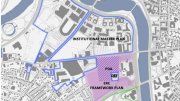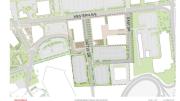Harvard has publicly filed its proposal to develop its “enterprise research campus” (ERC), a non-academic, commercial “innovation” district in Allston just south of Harvard Business School (HBS) and east of the new science and engineering complex. The filing triggers a 45-day period for public comment, after which the Boston Public Development Agency will consider the plan for approval. It covers an initial phase of what may, over time, become a much larger commercial district.
University officials had presented the proposal to Allston residents last week, many of whom voiced a ramge of concerns with the plan. Kevin Casey, Harvard’s associate vice president for public affairs and communications, said that the meeting “reinforced our view that we needed to move the filing forward so that we could get the full document out for people to refer to, because we felt limited in how we could respond to the questions [at the meeting] because people weren’t able to see how comprehensive the document would be.”
The Planned Development Area (PDA) Master Plan proposes developing a 14-acre parcel of land (see first schematic above)—itself a part of the larger, 36-acre ERC plot that has sat largely empty since the University acquired it in 2000. It anticipates 900,000 square feet of developed space just south of Western Avenue: 400,000 square feet of office and lab space; 250,000 square feet of residential space; and a 250,000-square-foot hotel and conference center, already described and approved in a 2013 Institutional Master Plan (IMP) covering Harvard’s Allston campus. The proposed uses occupy just part of the 14-acre site; on much of the rest, Harvard envisions large surface parking lots for 800 to 900 vehicles; those lots themselves will eventually be developed. These proportions may still change significantly in later stages of planning. No specific developments have been submitted for approval; the University will seek private development partners for specific sites after the initial planning review and approval, when granted.
The filing presented to Boston regulators yesterday outlines the use of a subset of the 14 acres, itself a subset of the larger 36-acre ERC. Longer term, when Massachusetts settles on a design for and reconstructs the nearby highway viaduct and intersection, a still-larger “Allston Landing South” tract would become available for redevelopment. So the current plan covers a small part of what may, over time, become a vastly larger project, of interest not only to current, nearby residents, but to the larger surrounding Boston and Cambridge communities. The economic and development impacts on, and potential for, the University also loom large.
According to the planning document, Harvard’s hope is to draw on the energy of HBS and Harvard’s applied scientists and engineers (who are scheduled to move in for the 2020-2021 academic year), and to connect the area to the Longwood medical area and other local universities. “We really think that we’re going to be developing a community which will have other types of academic entities, business, not-for-profits, and residential amenities, to create a community that is a real vibrant, sustainable, ecological system,” said University executive vice president Katie Lapp.
Road traffic and public transit access are of major concern both to Allston residents and the future occupants of the ERC. The proposal calls for new roads, including Cattle Drive, planned as the main north-south thoroughfare linking Western Avenue to Cambridge Street (use arrow to navigate to second rendering above), and East Drive, extending from Western Avenue toward a future commuter-rail stop called West Station (though the Massachusetts Department of Transportation indicated this week that that station will be delayed until 2040). Previous renderings of the ERC, from Harvard’s 2013 Institutional Master Plan for Allston, had emphasized a greenway oriented toward the Charles River rather than streets oriented toward the future West Station. Both the new roads would connect to the Massachusetts Turnpike and include five lanes of traffic and bike lanes, and Cattle Drive would also provide “a flexible zone in which to locate landscape and program elements, seating, kiosks, public art, etc.”
The PDA anticipates “a coherent pedestrian realm” developing along the new blocks:
[T]he success of the ERC as an urban district will also be contingent on the establishment of a robust mixed-use development program, including office, lab, research space, residential, retail, as well as a range of publicly accessible open spaces. This type of mix will ensure that the area is vibrant, with activity extending through the course of the day and evening. Along primary ERC main streets, a high degree of porosity and public interface is desired.
The plan also includes two public green spaces south of the office and lab buildings, which would connect to existing nearby green spaces; the planned spaces appear significantly smaller than the continuous greenway outlined in the 2013 IMP.
Harry Mattison, an Allston resident and member of the Impact Advisory Group that will advise Boston regulatory authorities on the University’s plan, said that plans for the ERC should be considered after broader community planning takes place: “What is urgently needed is community planning for North Allston including both the existing residential neighborhood, Harvard ERC, and other property owned by Harvard and others. This planning must be done before considering any specific zoning changes for Harvard. There are crucial topics including transportation, housing, and greenspace that deserve consideration in the larger, North Allston context.”
The PDA was submitted alongside a much broader “framework plan,” which is not up for regulatory approval, for the eventual development of the 36-acre space. While the initial, 14-acre parcel could be built on a time frame similar to the science and engineering complex, which is scheduled to be completed in 2020, the larger ERC landholdings could be under construction for another decade or more, depending on the progress of the concurrent realignment of the Massachusetts Turnpike in Allston and market demand for the facilities.









